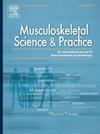The person-centered hypothesis framework: Advancing clinical reasoning in musculoskeletal pain management
IF 2.2
3区 医学
Q1 REHABILITATION
引用次数: 0
Abstract
Introduction
The Person-Centered Hypothesis (PCH) framework is a structured clinical reasoning model designed to enhance "in action" reasoning in person-centered care (PCC). The PCH integrates elements of the biopsychosocial model, pain phenotyping, and contextual factors, addressing gaps in real-time clinical decision-making.
Purpose
To describe the proposed PCH framework that synthesizes four domains: dominant pain phenotype(s), relevant clinical patterns, regional and co-existing contributors, and psychosocial and lifestyle influencing factors. This masterclass outlines the clinical use of the PCH framework, its ability to reduce cognitive load, and its alignment with precision medicine principles.
Implications
The PCH integrates with existing care models, offering clinicians a comprehensive and adaptable framework for managing musculoskeletal pain. By emphasizing reflective practice and prioritizing person-centered domains, the PCH helps clinicians navigate the complexities of diverse patient presentations and facilitates targeted evaluation and intervention strategies. While challenges in implementation exist, the PCH has the potential to improve patient outcomes and clinician confidence. Future research and educational initiatives are recommended to refine, validate, and assess the framework's effectiveness and support its adoption in clinical practice.
以人为中心的假设框架:推进肌肉骨骼疼痛管理的临床推理
以人为中心的假设(PCH)框架是一个结构化的临床推理模型,旨在增强以人为中心的护理(PCC)中的“行动”推理。PCH整合了生物心理社会模型、疼痛表型和环境因素的要素,解决了实时临床决策的差距。目的描述综合了四个领域的PCH框架:显性疼痛表型,相关临床模式,区域和共存的贡献者,以及社会心理和生活方式的影响因素。这个大师班概述了PCH框架的临床应用,它减少认知负荷的能力,以及它与精准医学原则的一致性。PCH整合了现有的护理模式,为临床医生提供了一个全面和适应性强的框架来管理肌肉骨骼疼痛。通过强调反思实践和优先考虑以人为本的领域,PCH帮助临床医生应对不同患者表现的复杂性,并促进有针对性的评估和干预策略。虽然在实施中存在挑战,但PCH有可能改善患者的治疗效果和临床医生的信心。建议未来的研究和教育活动来完善、验证和评估该框架的有效性,并支持其在临床实践中的采用。
本文章由计算机程序翻译,如有差异,请以英文原文为准。
求助全文
约1分钟内获得全文
求助全文
来源期刊

Musculoskeletal Science and Practice
Health Professions-Physical Therapy, Sports Therapy and Rehabilitation
CiteScore
4.10
自引率
8.70%
发文量
152
审稿时长
48 days
期刊介绍:
Musculoskeletal Science & Practice, international journal of musculoskeletal physiotherapy, is a peer-reviewed international journal (previously Manual Therapy), publishing high quality original research, review and Masterclass articles that contribute to improving the clinical understanding of appropriate care processes for musculoskeletal disorders. The journal publishes articles that influence or add to the body of evidence on diagnostic and therapeutic processes, patient centered care, guidelines for musculoskeletal therapeutics and theoretical models that support developments in assessment, diagnosis, clinical reasoning and interventions.
 求助内容:
求助内容: 应助结果提醒方式:
应助结果提醒方式:


